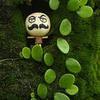Lesson Two: Changdeokgung
Changdeokgung was built in 1405 as a secondary palace of the Joseon dynasty (the main palace being Gyeongbokgung). Changdeokgung was added to the UNESCO World Heritage List in 1997 for its layout which adapted to the topography and natural setting. Parts of the palace was destroyed during the Japanese occupation (1910-1945) and restoration has been ongoing since 1991.
Donhwamun, the main gate of Changdeokgung, was where the king would pass during royal ceremonies (his attendants used another gate). Donhwa means "great virtue teaches people and influences them to be warm hearted." This is the oldest existing main gate in Korea.
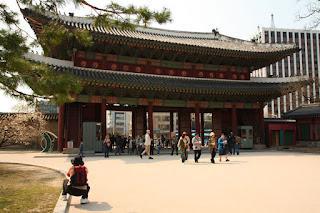 If you pass thru this gate will you become warm hearted?
If you pass thru this gate will you become warm hearted?The Geumcheongyo bridge is the oldest structure in Changdeokgung palace. This stone bridge leads to the Jinseonmun gate where the king installed Sinmungo, a drum that commoners can supposedly strike to voice out their grievances. Supposedly is the operative word. In truth, it was difficult for commoners to have permission to strike the drum. They had to have approval from the magistrate, governor, and general just to pass thru the main gate (Donhwamun) to get to the drum.
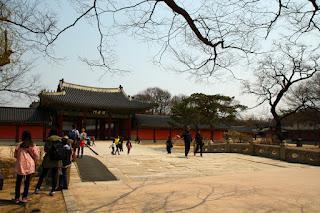 Geumcheongyo bridge leading to Jinseonmun gate
Geumcheongyo bridge leading to Jinseonmun gateCheongdeokgung's throne hall is called Injeongjeon. Just like Gyeongbokgung's throne hall, this was where meetings and coronation ceremonies were held. And just like the main palace's throne hall, it is a one story building that looks like two stories on the outside.
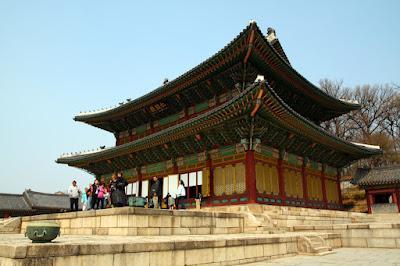 Injeongjeon
InjeongjeonThe path leading to the throne hall is divided into three, only the king can use the center path. Stones where ranks of the officials were carved, mark where they sit during meetings.
 Your rank, your spot
Your rank, your spotPeering closely at the ceiling, you will find five-pronged devices curiously sticking out. These are to prevent birds from creating their nests. Other buildings will have nets under the eaves, also to keep the birds away.
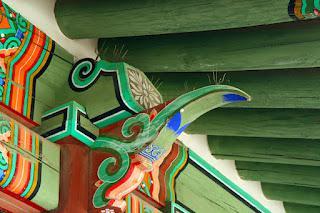 Hey birdie, you can't set up shop here
Hey birdie, you can't set up shop hereThe king discussed affairs with high ranking officials at a building called Seonjeongjeon. It was also used to house ancestral tablets of deceased kings and queens. This is the only building in Changdeokgung with a blue roof.
 The only blue tiled roof in the palace
The only blue tiled roof in the palaceThe king spent most of his time at Huijeongdang, originally his bed chamber then became his workplace. The arched driveway was constructed later on for automobiles. The last royal family member lived in the palace until her death in 1989.
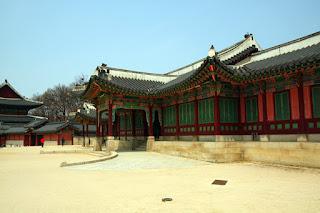 See something modern here?
See something modern here?Other structures you can find in the palace are: Daejojeon (where the queen lived), Gwolnaegaksa (government offices), Seonwonjeon (where portraits of former kings were stored and where ancestral rites were performed). Is your tongue all in a twist yet?
Third Dose, Overdose: Huwon, Changdeokgung's Secret Garden
The secluded rear garden of Changdeokgung was a recreational area for the royal family. This was where they would relax by fishing in the ponds, read books, write poetry, and have banquets.
Around the rectangular pond called Buyongji, are the royal libraries, Yeonghwadang pavilion where exams were held, and Buyongjeong pavilion for retreats. This area was mainly used for studying.
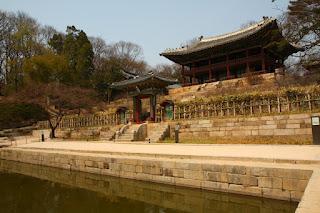 The royal libraries up top facing the pond
The royal libraries up top facing the pond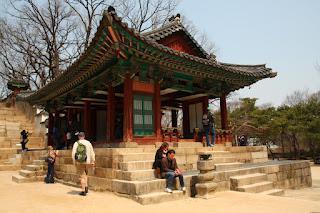 Yeonghwadang pavilion
Yeonghwadang pavilionThe pond called Aeryeon, meaning "loving the lotus flowers", did not live up to its name...I did not see any lotus flower here :-)
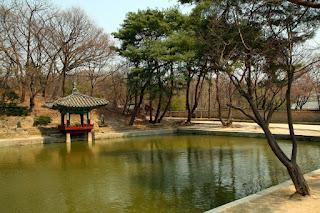 The pond with invisible lotus flowers :-)
The pond with invisible lotus flowers :-) Yeongyeongdang was built in 1828. The area has separate women's and men's quarters, but these were connected inside. The kitchen is located behind the women's quarters, since the area sometimes served as a venue for parties.
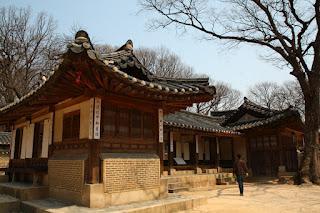 Yeongyeongdang
Yeongyeongdang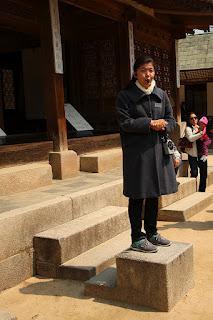 Stone platform found only in the men's area... for mounting/dismounting horses
Stone platform found only in the men's area... for mounting/dismounting horsesThere are five pavilions surrounding Ongnyucheon, the brook that runs through the secret garden. One that stands out is the thatched-roofed pavilion called Cheonguijeong. Surrounding it is a small area where rice is planted. The rice stalks from this field is used for the pavilion's roof.
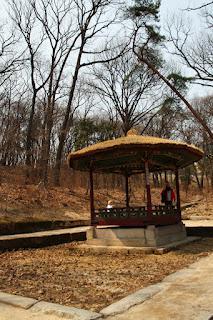 Plant your own roof
Plant your own roofIn Ongnyucheon area, there is a rock carved with a groove where the water from the brook flows. The king and his men had games here where they let their wine cups float on the water. Before the cup reaches downstream, the owner of the cup must compose a poem. The punishment was to drink three cups of wine. I am guessing most of them chose to lose. ;-)
There are several more ponds and pavilions of different shapes and sizes in the garden. It is an enormous garden and without a guide, I am sure you will get lost (there are no directional signs).
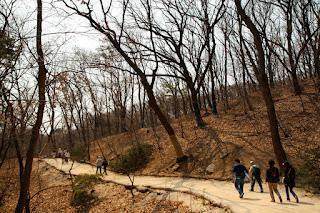 The long way out (unless you want to trace your steps and go back where you started)
The long way out (unless you want to trace your steps and go back where you started)Spring hadn't sprung yet when I visited thus the all-brown surroundings. I am sure it would have been beautiful in full bloom.
That's it for our history lessons! I did not go to the other palaces even if I had the integrated ticket (10,000 won for entrance to Gyeongbokgung, Changdeokgung, Huwon, Changgyeonggung, Deoksugung, and Jongmyo Shrine). If I had one month (the ticket was valid for a month), I might have visited the other places. But three sites in three days was too much information for me.
Tip: To fully appreciate the palace and the garden, grab a guidebook or an audio guide or join a guided tour. If you don't, you'll find it a snooze fest since the structures look so much alike. And if you plan to visit all these places: Gyeongbokgung, Changdeokgung, Huwon or Secret Garden, Changgyeonggung, Deoksugung, and Jongmyo shrine, buy the integrated ticket for 10,000 won. You will save 4000 won.
Changdeokgung
Find your way: Take the subway to Jongno 3(sam)-ga station (line 1/3/5) and take exit 6 or to Anguk station (line 3/orange) and take exit 3.
Admission fee: 3000 won
Hours: 9AM to 6PM (up to 5PM only from November to March) daily except MondaysEnglish guided tour: 1030AM and 230PM
Huwon (Secret Garden)
Find your way: Follow directions above since the Secret Garden is in Changdeokgung palace
Admission fee: 5000 won
Hours: 9AM to 6PM (up to 5PM only from November to March) daily except MondaysEnglish guided tour: 1130AM and 230PM (takes 1 hour and 40 minutes)
While you're in the area, why don't you drop by:
Gyeongbokgung (palace)Changgyeonggung (palace)Jongmyo ShrineBukchon Hanok Village Insadong (shopping)Cheonggyecheon(stream)
South Korea Series:Tourist Visa to KoreaRandom Things About KimchilandFrom One Point to AnotherHomes Away From HomeMy First Meal is Not KoreanYou Will Never Go Hungry Here To the North We Go...Almost
Strolling, Collecting Sights
A Dose of History: Gyeongbokgung
Double Dose of History: Changdeokgung & Huwon (you're here!)
